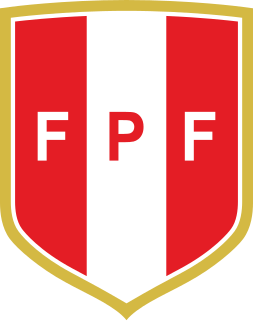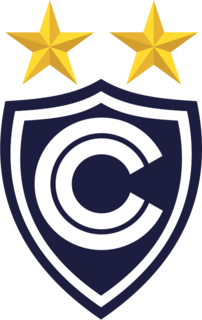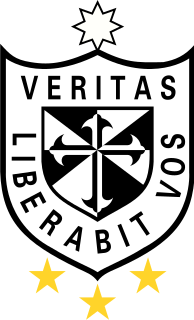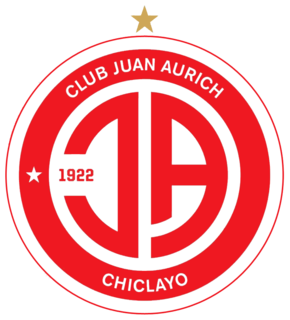
The Peru national football team represents Peru in men's international football. The national team has been organised, since 1927, by the Peruvian Football Federation (FPF). The FPF constitutes one of the ten members of FIFA's South American Football Confederation (CONMEBOL). Peru has won the Copa América twice and qualified for FIFA World Cup finals five times ; the team also participated in the 1936 Olympic football competition and has reached the semi-finals of the CONCACAF Gold Cup. The team plays most of its home matches at the Estadio Nacional in Lima, the country's capital.

Club Alianza Lima, popularly known as Alianza Lima or simply Alianza, is a Peruvian professional sports club based in La Victoria District of Lima, Peru. It is widely known for having one of the most historical and successful football teams of Peru; they have won a total of twenty-four league titles of the Peruvian Primera División and was the oldest team playing in that competition, since the club was founded in 1901. The club currently competes in the Liga 1, the first tier of Peruvian football.

Club Universitario de Deportes, popularly known as Universitario and La "U", is a Peruvian football club located in Lima. The club was founded in 1924 under the name Federación Universitaria by students of the National University of San Marcos but was forced to rename in 1931. Since 1928, the club competes in the top tier of Peruvian football, the Torneo Descentralizado. In 2000, they opened the 85,000-capacity stadium Estadio Monumental, currently the largest stadium in Peru and South America, retiring their smaller Estadio Teodoro Lolo Fernández. Universitario and Alianza Lima participate in the Peruvian Clásico, which has its roots in the club's first participation in the Primera División in 1928. It also has rivalries with Sporting Cristal, Deportivo Municipal, and Sport Boys.

The Estadio Nacional of Peru is a multi-purpose stadium located in Lima, Peru. Its current capacity is 40,000 seats as stated by the Peruvian Football Federation without the lodges for some thousands more. The stadium was first inaugurated on 27 October 1952 for the 1953 South American Championship—replacing the Stadium Nacional—and is Peru's principal and national stadium. It has hosted three of the six South American Championship/Copa América football competitions held in Peru. It is referred to as the Coloso de José Díaz because of its proximity to a street of the same name. It is the home ground of the Peru national football team. The IPD —a branch of the Ministry of Education—is the stadium's administrating entity. The stadium has undergone several renovations for tournaments such as the 2004 Copa América. The artificial turf was installed for the 2005 FIFA U-17 World Championship. It will probably be used at the 2021 FIFA U-17 World Cup. The most recent renovation started in 2010 and concluded in 2011. The re-inauguration ceremony of the renovated stadium was held on 24 July 2011 with a match between the Peru national under-20 football team and the Spain national under-20 football team.

The Estadio Monumental is a football stadium in the district of Ate in Lima, Peru. It is the home of Club Universitario de Deportes, and it was opened in 2000 to replace the Estadio Teodoro Lolo Fernandez. Its owner is Gremco S.A. according to the president of Universitario Javier Aspauza. Designed by Progreso International and Gremco S.A., Uruguayan architect Walter Lavalleja Sarriés led the construction of the stadium. It is Peru's largest stadium and also the largest in South America. It has a total capacity for 85,000 spectators, Certificate ITSE N°000112-2016-IPD. The stadium was built in accordance with FIFA’s manual of technical specifications for World Cup finals.

Club Sportivo Cienciano is a professional football club based in Cusco, Peru that currently plays in the Peruvian Primera División.

Estadio Alberto Gallardo is a football stadium in the Rimac District of Lima, Peru, named after Alberto Gallardo, a former Peruvian football player and manager who played several years for Sporting Cristal. It is the home of football club Sporting Cristal. The stadium was built in the 1960s along the Rímac River for local football use and originally named Estadio San Martín de Porres. Many clubs playing in the Primera División, Segunda División, and district leagues of San Martín de Porres were among the many tenants the stadium had. In 1995, Sporting Cristal—one of the regular first division tenants of the stadium—decided to lease the venue from the Instituto Peruano del Deporte for 17 years. In 2012 the club signed a new lease contract for 10 years and will expire in 2022. The stadium itself has hosted few high-risk matches due to the limited access to the stadium and the low capacity of 11,600.

Club Deportivo Universidad San Martín de Porres, commonly known as USMP, is a Peruvian football club based in the city of Lima. The club was founded in 2004 as a joint stock company, the first in Peru. In just their first season, the club began playing in the Peruvian top-flight, the Torneo Descentralizado, after they bought the promotional place of the 2003 Segunda División winners, Sport Coopsol. The team obtained their first Descentralizado title in 2007, the second in 2008 and their third in 2010.

Club Juan Aurich S. A., commonly known as Juan Aurich, is a professional football club based in Chiclayo, Peru. The original Juan Aurich club was founded in 1922, this incarnation however was founded in 2005; they play in the Torneo Descentralizado where they have been playing since attaining promotion when they won the 2007 Copa Perú. They play their home games at the Estadio Elías Aguirre.
The 2001 Torneo Descentralizado, was the 85th season of the top category of Peruvian football (soccer). It was played by 12 teams. The national champion was Alianza Lima.
The 1999 season of the Torneo Descentralizado was the 84th season of the top category of Peruvian football (soccer). It was played by 12 teams. The national champion was Universitario.
The 1998 season of the Torneo Descentralizado was the 83rd season of the top category of Peruvian football (soccer). It was played by 12 teams. The national champion was Universitario.

Carlos Alejandro Villanueva Martínez was a Peruvian footballer who played for Alianza Lima and the Peru national football team. He is considered one of the most important Alianza strikers in the 1920s and 1930s.
The 1993 Torneo Descentralizado was the 78th season of the top category of Peruvian football (soccer). A total of 16 teams competed in the tournament. Universitario de Deportes conquered its twenty-first Primera División.
The Peruvian Clásico or the Classic of the Classics of Peruvian Football is the name given to Peru's biggest football derby between Alianza Lima and Universitario. The rivalry between these two clubs started in their first game on 23 September 1928 when the two first faced off in a violent game. Both clubs come from the capital city, Lima.
Football is the most popular sport in Peru. Football in Peru was introduced by British immigrants, Peruvians returning from Great Britain, and by English sailors in the later half of the 19th century during their frequent stops at the port of Callao, which at that point was considered one of the most important ports of the Pacific Ocean. According to the work entitled La Difusion del Futbol en Lima, during the last decade of the 19th century, records show that sailors were known to practice sports such as football and played against teams made up of Englishmen, Peruvians, or a mix between Englishmen and Peruvians.

The Estadio Nacional disaster of 24 May 1964 is, to date, the worst disaster in association football history. It occurred during a game of Peru versus Argentina. During the match, there was an unpopular decision given by the referee. Outraged, the Peruvian fans decided to invade the pitch. Police retaliated by firing tear gas into the stadium crowd, causing a mass exodus. The deaths mainly occurred from people suffering from internal hemorrhaging or asphyxiation from the crushing against the steel shutters that led down to the street.
The 2011 U-20 Copa Libertadores was the first edition of this U-20 club competition. Players born on or after 1 January 1990 were eligible to compete. The tournament was originally going to be hosted in November 2010, however, because of the postponement, players born in 1990 were allowed to play, otherwise only players born after 1 January 1991 would have been eligible.
The 2012 U-20 Copa Libertadores was the second edition of this U-20 club competition. Players born on or after 1 January 1992 were eligible to compete. The tournament was played in Lima, Peru.
The 2019 Copa Libertadores group stage was played from 5 March to 9 May 2019. A total of 32 teams competed in the group stage to decide the 16 places in the final stages of the 2019 Copa Libertadores.













